Normal Vision
In normal vision (not involving near-sightedness, far-sightedness or astigmatism of the eyes), the light is refracted by the cornea and vitreous body as it passes through to focus correctly on the retina.

Near-sightedness
Near-sightedness is caused by excessive protrusion of the cornea making the focus of the light to be in front of the retina. Objects far away become blurry and cannot be seen clearly.
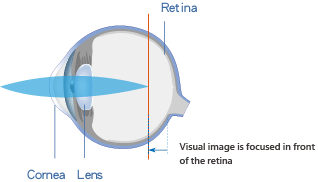
Far-sightedness
Far-sightedness is due to the flatness of the corneal curvature making the focus of the light be behind the retina. Objects near become blurry and cannot be seen clearly.
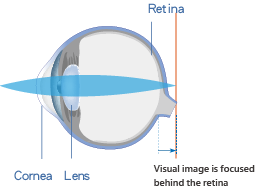
Astigmatism
Astigmatism is more than one foci in front or behind the retina. Objects become blurry, or with two or three superimposing images.
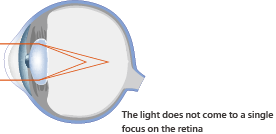
Presbyopia
The lens loses elasticity as one grows old, with reduced regulatory performance, resulting in light beams focusing behind the retina after they enter the eye and close objects appearing blurry.
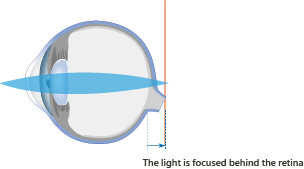
LASIK (Laser in situ Keratomileusis) is a type of operation to restore vision by irradiation of the excimer laser through the cornea, modifying the refractive condition of the eye to correct near-sightedness, astigmatism, and far-sightedness. During the LASIK procedure, a circular corneal flap is made on the surface of the cornea to expose the corneal stroma underneath. The LASIK is used to irradiate the corneal stroma to restore vision. Since the circular corneal flap will be replaced after irradiation, the LASIK is a therapy that has fewer problems and is safer for the eye.

LASIK is a type of vision restoration surgery that is widely known by the public in recent years. The reason why the procedure is becoming so popular is because compared to other equipment or methods of vision correction, the LASIK procedure is "more safe and precise," "requiring 10 minutes of operation time only," "the sensation of pain is slight during and after the operation," and "vision is restored immediately after the procedure;" a wide range of patients all agreed on these characteristics and gave positive support and appraisal, which is the reason why LASIK has become so common.
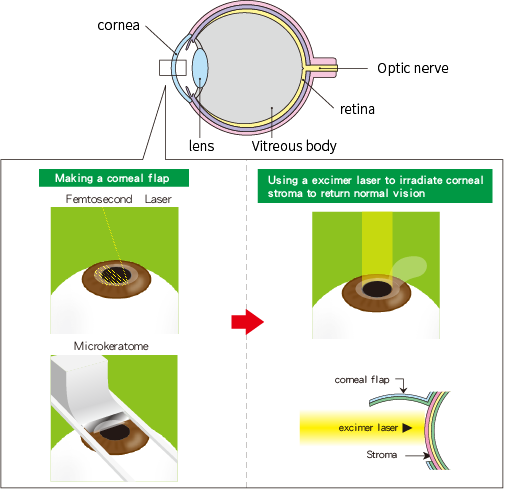
LASIK procedure is to make a circular corneal flap on the surface of the cornea to expose the corneal stroma underneath; then use excimer laser to irradiate the stroma in order to return the corneal curvature to normal so that the lights can focus on the retina. The corneal flap is returned to normal position after irradiation, thus minimizing the stress on the eyes and the chances of infection.
The blade-free femtosecond laser is used to gently treat the cornea of middle aged to elderly people. Quality corneal flaps are produced safely.
With the non-spherical excimer laser, the diopters of both eyes are adjusted to the extent that one of them is close to zero and the other remains at +.25 to +1.5 and use "monovision" to adjust one eye to see near and one eye to see far to compensate for that.
Non-spherical excimer laser is conducive to reinforcing the visual depth of field, improving the weakness of conventional laser of having blurry views at a medium distance. It works significantly for those who like to read books and newspapers and users of computers and 3C products.

The LASIK features the use of femtosecond laser at a technical level that is on a par with its counterparts around the world in the production of high-quality flaps. When it comes to reduced degree of myopia, on the other hand, the advanced excimer laser is applied for enhanced surgical outcome and quality.
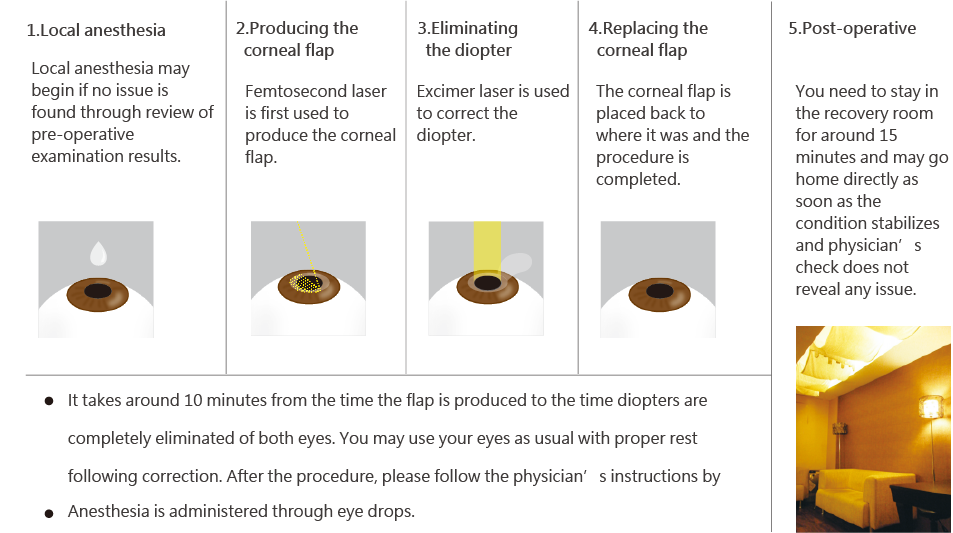
The Largest Refractive Vision Correction Center in Taiwan
Universal Eye Center has made several national achievements being one of the most well known eye clinics in the country, and the first to introduce LASIK procedure with the experience of more than 150 thousand LASIK operations. Universal Eye Center has received the certification for the "Symbol of National Quality" as a "High-Quality Laser Vision Correction Center." The center also passed ISO9001 international quality auditing, being the only eye clinic in the country to receive dual certification. Each branch is conveniently located at the center of the city with peaceful, clean, and bright interior design. In addition, we have the world’s top of the line equipment such as Ziemer Femtosecond Laser and Advanced Excimer Laser manufactured by Zeimer, taking the field of vision correction procedure in the nation to another realm.
Achievements
2005 Universal Eye Center received "Symbol of National Quality" as a "high-quality laser eye vision correction center".
2006 Received the "National Outstanding Small and Medium Enterprises Award," the first service-type business to be awarded.
2007 Universal Eye Center passed the auditing for "ISO 9001" certification.
2009 Universal Eye Center Group received "Superior Brands in Business Service Industry" the from Ministry of Economic Affairs.
2010, 2013 & 2016 Joint Commission International (JCI) certified eye center.
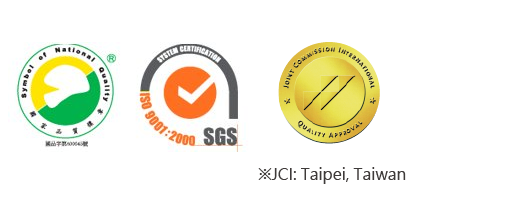
Strong Medical Background and Extensive Clinical Experience that is Second to None
Universal Eye Center has dozens of ophthalmologists; our own doctors also instruct LASIK operation to other ophthalmologists at the Chinese ophthalmologic association. With such a strong medical team, we are proud to claim to be the specialists in LASIK procedures, and the best in the nation. With an excellent team composed of professional nurses, LASIK consultant, and clinical engineers, we provide high quality and safe therapy.
With the best resources of medical team gathered from the eye clinics in Taiwan
Chief surgeons to conduct training in LASIK techniques in the United States and Canada
Team of chief surgeons have accumulated over 150 thousand clinical experiences.
Repeatedly invited by the medical association to serve as instructors for other physicians.
Repeatedly invited domestically and internationally for speeches on topics related to LASIK
We have a team of physicians with experience of over 10 thousand cases. Other than providing high quality medical care, we contribute to the development of vision correction in Taiwan; other than surgery for near-sightedness, we devote ourselves on the treatment of presbyopia and cataracts.
Certification
Other than substantial clinical experiences, all physicians at Universal Eye Center have a high level of knowledge.

Introduction to Staffs
-
Receptionist
Responsibility of a Receptionist
To calm patient’s anxiety, to listen carefully and to provide recommendations to the patients. This includes answering relevant questions over the telephone and management of medical records. Every process is conducted from the patient’s point of view.
Universal Eye Center Creates a Vivid and Colorful New Vision
Since Universal Eye Center has performed numerous cases in Taiwan, we often hear questions such as "laser operation is scary" or "is the procedure safe?" We would like to spread the joy of vision restoration to more people by providing more relief and peace of mind to the patients. We can pick-up the patients for check-ups, introduce the surgeons, or bring the patients to the nurses easily and smoothly to avoid disturbances to the patients. -
Nurses
Establishing a Relaxed Environment for Treatment
The major task for the nurses is to assist in examination and surgery. Since a great number of patients will schedule their visits on the weekends, we hope that the nurses can provide support to the patients so they can go through the examination and operation without anxiety, no matter how busy the clinic becomes. Further, each step of the process by the medical staff is executed with care to provide safe treatment and environment for the patient. Therefore, we pay extra attention to our works so that the patients can feel relieved and comfortable.
Strict Guidance and Continuous Training
The nurses are trained by professional instruction on important knowledge and techniques. All nursing staff receive scheduled professional training to maintain a relaxed examination process and safe operating system for the patients. -
Laser Surgery Consultant
Highly Precise Examination to Establish a Customized Treatment Plan
The data from the shape of the cornea, eye pressure, corneal endothelial cells, aberration measurement, visual acuity test, and thickness of the cornea, all correspond with each other. We use various equipment to get a hold of the condition of the eye from different angles. The analysis provides detailed information to the physician to determine if the patient is suitable for the operation. -
Clinical Engineers
Having Our Own Nationwide Maintenance Team
Clinical technicians help maintain the equipment at their best working condition to support the surgeons during the operation.
Providing the Newest Techniques and the Best Surgery
n order to provide the safest and highest quality medical care to each patient and to spread the benefit of LASIK procedure to more people, we carry out our daily work attentively. To provide the patients with a better environment for the operation, the communication between LASIK consultants, physicians and nurses is important; our medical team has spent enormous time on training to provide better medical quality. New staff receive one-on-one from experienced internal and external instructors on ophthalmic knowledge and surgical techniques.
- Iris positioning + leading wave
- Precise locating of eyeball shifts and reinforced visual quality at night
- Iris positioning + leading wavee
- Inverted bezvel-in side cut corneal flap for increased stability and quick recovery
- Elliptical corneal flaps to greatly reduce eye dryness
- Precise locating of eyeball shifts and reinforced visual quality at night
- 7-Dimension full-eye tracking system to effectively address the issue of eyeball shifting
- PCSC pupil center displacement compensation for improved accuracy in correcting the diopter
- CTA eyeball self-rotating correction where the corrective center point is chosen reflective of the patient’s condition (pupil center or visual center)
- WFO for optimized treatment of aberration in the leading wave to keep the non-spherical essence of the cornea and to maintain personalized natural effects
- Precise non-spherical laser Custom-Q for enhanced depth of field and to strengthen quality of visual acuity at a long, medium, and short distance and to better suit the presbyopia population
- This solution is capable of precisely locating eyeball shifts and reinforced visual quality at night (including iris positioning and the leading wave)
+Contoura corneal mapping analytical system
- Certified by the US FDA
- 360° circular corneal mapping to completely record personal corneal status
- Precise values along with non-spherical data to ensure optimal post-operative quality of visual acuity at night
- Personalized cornea suitable for people with astigmatism and to ensure high-quality post-operative visual effects with reduced high-order aberrations
- The non-spherical structure of personal cornea is measured completely based on the corneal mapping to render surgical settings closely reflective of personal needs.
Inverted bevel-in side cut corneal flap for increased stability and quick recovery
- Elliptical corneal flaps to greatly reduce eye dryness
- 7-Dimension full-eye tracking system to effectively address the issue of eyeball shifting
- PCSC pupil center displacement compensation for improved accuracy in correcting the diopter
- CTA eyeball self-rotating correction where the corrective center point is chosen reflective of the patient’s condition (pupil center or visual center)
- WFO for optimized treatment of aberration in the leading wave to keep the non-spherical essence of the cornea and to maintain personalized natural effects
- Precise non-spherical laser Custom-Q for enhanced depth of field and to strengthen quality of visual acuity at a long, medium, and short distance and to better suit the presbyopia population
- This solution is capable of precisely locating eyeball shifts and reinforced visual quality at night (including iris positioning and the leading wave)
WaveLight FS200 Femtosecond Laser
he Germany WaveLight FS200 ultra-fast femtosecond laser is known for its rapid production of high-quality corneal flaps to help improve post-operative quality and relieve the discomfort felt during the procedure.
With a scanning frequency up to 200kHz, corneal flaps are quickly produced.
The novel inverted bevel-in side cut corneal flap is known for its high stability, quick recovery, and minimal dryness in the eyes.
Minute light spots, 0.1 μJ – 2.0 μJ low-pulse energy, smooth and exquisite corneal flap.
WaveLight EX500 Excimer Laser
During refractive correction, the use of WaveLight EX500 improves surgical effects and quality.
The rapid 500 Hz excimer laser scanning frequency shortens the duration of treatment and reduces the possibility of dehydrated corneal stroma, with optimal post-operative quality.
Seven-dimension full-eye tracking applying 1050 Hz, synchronized with the 500 Hz laser, with only 0.002 seconds of response time, effectively solves the issue of the eyeball moving around during the procedure.
Complete tailored regimens provide individuals with exclusive integrated solutions reflective of their unique refraction.
SMILE
Software module for Small Incision Lenticule Extraction SMILE® from ZEISS enables the first Small Incision Lenticule Extraction procedure for minimally invasive laser vision correction. It offers a potentially lower incidence of transient dry eye syndrome and a wider preservation of biomechanical stability.
- Based on Nobel Prize-winning technology (Nobel Prize in Physics 2018)
- Treatment planning and execution aided by a software wizard
- Schematic visualization of cutting patterns during treatment planning
✔ Lenticule creation
ZEISS SMILE provides an intuitive and easy-to-use treatment planning interface for Small Incision Lenticule Extraction.
✔ Minimally invasive
With ZEISS SMILE, only a small incision of 2 mm is sufficient, meaning that the majority of the upper corneal layers remains untouched. The lamellar incision area is roughly 1/3 smaller than for Femto-LASIK treatment. What's more, the patient can usually return to their normal daily activities the next day.
✔ All-femto
ZEISS SMILE precalculates all intracorneal cuts necessary for the vision correction. The entire procedure is carried out in a single treatment process exclusively on the ZEISS VisuMax femtosecond laser.

SMILE Pro 2.0
✔ Intelligent assistant systems
✔ OcuLign: easy cyclotorsion alignment
✔ CentraLign: little effort during centration
Certified by the US FDA.
360° circular corneal mapping to completely record personal corneal status.
Precise values along with non-spherical data to ensure optimal post-operative quality of visual acuity at night.
Personalized cornea suitable for people with astigmatism and to ensure high-quality post-operative visual effects with reduced high-order aberrations.
-
The non-spherical structure of personal cornea is measured completely based on the corneal mapping to render surgical settings closely reflective of personal needs.

FDA-certified, suitable for special eye conditions
Astigmatism
High power
Asymmetrical corneas
Irregular corneas
-
Myopic astigmatism, among others
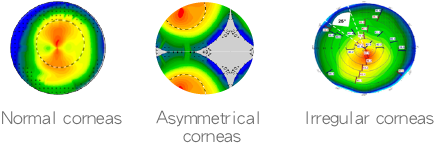
Personalized treatments reflective of different corneal conditions
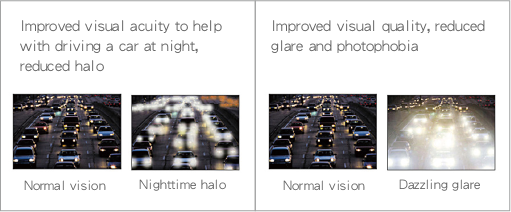
Highlights of post-operative care
Photophobia, tearing, abnormal sensation, and unsteady visual acuity are likely over a short period of time after the procedure. Please keep your eyes closed and take a rest as much as possible. Such sensations will gradually disappear in about 3 to 4 hours.
It is strictly prohibited to rub your eyes, particularly the upper eyelids, within one month after the post-operative period (which might vary depending on the type of procedure and personal body composition). Eye makeup needs to be avoided.
You should prevent against infection caused by foreign matters getting into the eye (such as dust, water, mosquitoes, and insects, among others) during the post-operative period.
Swimming, sauna, and collision sports (basketball, football...) need to be suspended. You need to wear goggles while staying outdoors.
-
You need to wear blindfolds at night during sleep within one month during the post-operative period (which might vary depending on the type of procedure and personal body composition) in order to prevent against spontaneous rubbing of eyes.
-
Visual acuity will recover relatively slowly for you to see objects at a short distance after the procedure. Slight glare is likely when you drive at night. Please be careful.
-
Your eyes will become dry and tired easily during 1 to 3 months after the procedure. Please apply eye drops regularly to help correct the symptoms.
-
Subconjunctival hemorrhage, if it does occur during the post-operative period, will disappear on its own in 2 to 3 weeks.
-
When applying eye drops, simply hold the lower eyelid in the open position to facilitate administration. Do not hold the upper eyelid. This will avoid accidental poking.
Artificial tears increase the comfort felt by the eyes. You may increase the application frequency if necessary.
-
In case of a sudden reduction in visual acuity or acute pain, redness or swelling after the procedure, please return it to the physician as soon as possible.
If other eye disorders or allergies to drugs occur during the recovery period, please return for a visit immediately.
Please follow the physician's instructions by taking medicine and attending scheduled visits.